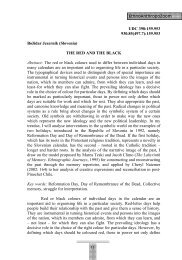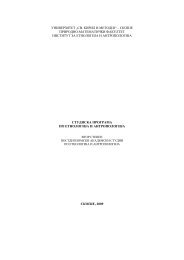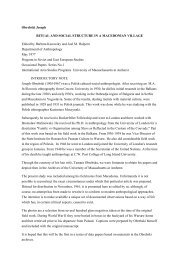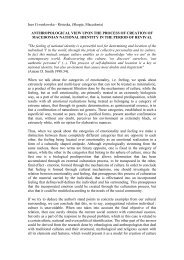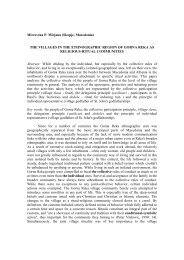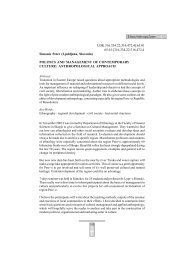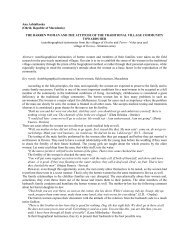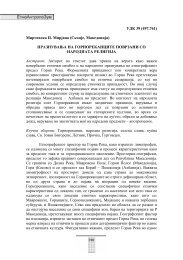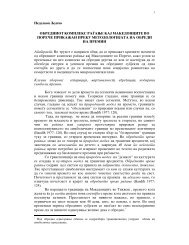Halpern M. Joel, Kerewsky-Halpern Barbara (USA)
Halpern M. Joel, Kerewsky-Halpern Barbara (USA)
Halpern M. Joel, Kerewsky-Halpern Barbara (USA)
Create successful ePaper yourself
Turn your PDF publications into a flip-book with our unique Google optimized e-Paper software.
12345<br />
12345<br />
12345<br />
12345<br />
12345<br />
12345<br />
12345<br />
12345<br />
12345<br />
12345<br />
12345678901234567890123456789012123<br />
12345678901234567890123456789012123<br />
EthnoAnthropoZoom<br />
12345678901234567890123456789012123<br />
12345678901234567890123456789012123<br />
12345678901234567890123456789012123<br />
all the monasteries in the town is Sveti Jovan. It is a tiny and picturesque, set on a<br />
rocky crag with the shallow blue-green water of the lake below. There are willows and<br />
yellow wild flowers growing out of the cracks of the rock on which it stands. It contains<br />
a tiny but richly decorated chapel. The most interesting feature was, however, upstairs<br />
which contained the monks quarters overlooking the lake. There was also a wine<br />
storage cellar and a pig-roasting spit. The museum in Ohrid is also a nice place to visit.<br />
It is housed in a Turkish style house and was the residence of wealthy early 19 th<br />
century merchants.<br />
In Ohrid too a car was provided. This time it was a jeep. We had the good fortune to go<br />
to the small town of Struga, on the northern end of the lake, on market day. This market,<br />
of all we have seen, was certainly the most colorful. It was very well-organized and<br />
regimented, thus not as natural appearing as it might be. This year they built rows of<br />
brick and wood stalls in a modern design as well as a meat department housed in a<br />
glass-enclosed building with a stone floor. It was most functional and attractive. One<br />
row of stalls was for crafts. These included opanci (sandals), pottery, and horn set<br />
knives among other items. Another row was for vegetable sellers, then there was one<br />
for cheese and other for dairy products. (Women were prominent here.)<br />
The grain selling and livestock trading (which was the sphere of men) took place in a<br />
large open area at the end of the market area. There (apparently) was no place set aside<br />
for women selling handiwork so they squatted on the curbs between the rows of stalls<br />
with their wares in their laps. We bought several pairs of brightly colored hand knitted<br />
socks. (Although they were made in the traditional form). Their ethnographic value is<br />
lessened as they are black, rose, yellow, green and purple, far from the orange, red and<br />
black which are the traditional colors of this region.<br />
We did, however, buy them because they will make colorful and interesting gifts.(We,<br />
of course, falsely assumed that “real“ folk arts were unchanging and not responsive to<br />
changes in economic patterns and stylistic innovations.) Everyone (the women) was<br />
in costume. There were variations in national dress in the villages within the small<br />
radius around Struga. This is amazing. I think <strong>Joel</strong> got some swell pictures before it<br />
started to rain. Before going back to Ohrid we were stopped at the pre-war natural<br />
history museum in the town (Although we were not conscious of the situation at that<br />
time, natural history museums were apparently given a lower priority than those of<br />
history and even folklore since their ideological function was less manifest.) .<br />
On Sunday, May 30th, we went with a pleasant German doctor, his wife and son in their<br />
car to the monastery of Sveti Naum, at the far south end of the lake, about 50 yards<br />
from Albania. This doctor was a POW for four years in Oklahoma and Arkansas and<br />
speaks English pretty well, so we didn’t have to struggle with German and French. The<br />
art historian from the museum went with us, too. It was very hard for six to fit into the<br />
tiny car but it was certainly nice of him to let us come. From the town of Ohrid to Sveti<br />
Naum is 15 miles, about a 45 minute drive along the cost of Lake Ohrid. Sometimes we<br />
would wind around small mountain passes and often the “road“ went across the sand<br />
on the shore. This was the case when we passed through the fishing village of Pe{tani.<br />
161<br />
12345<br />
12345



